How effective is our content marketing?
It’s a common question.
Unlike paid acquisition, it can be difficult to tie back direct conversions from content marketing and SEO.
It’s also a channel that takes longer to show results. Write a blog post in January, and you might not see it peak in traffic or conversions until August.
There are also unmeasurable benefits to content marketing, such as building website authority, building trust and credibility, and generating leverage for activities like partnerships.
Because of these reasons, when you think of content marketing attribution, you need to think a bit differently.
Despite this, we’re going to answer the question, “how do you measure the effectiveness of content marketing?”
I’m going to give you three flavors of answers: one philosophical, one theoretical, and one simple, but practical.
Perfect Attribution is Impossible and Not Valuable
“All models are wrong, but some are useful.”
- George E.P. Box
Attribution is the act of assigning credit to a given touchpoint. It helps you weigh the relative impact of campaigns in relation to your overall marketing and sales program.
In attribution modeling in general, you’re always going to sacrifice some accuracy for utility. There’s simply no objective way to assign “credit” to a given touchpoint that doesn’t implicitly contain one or more arguable assumptions.
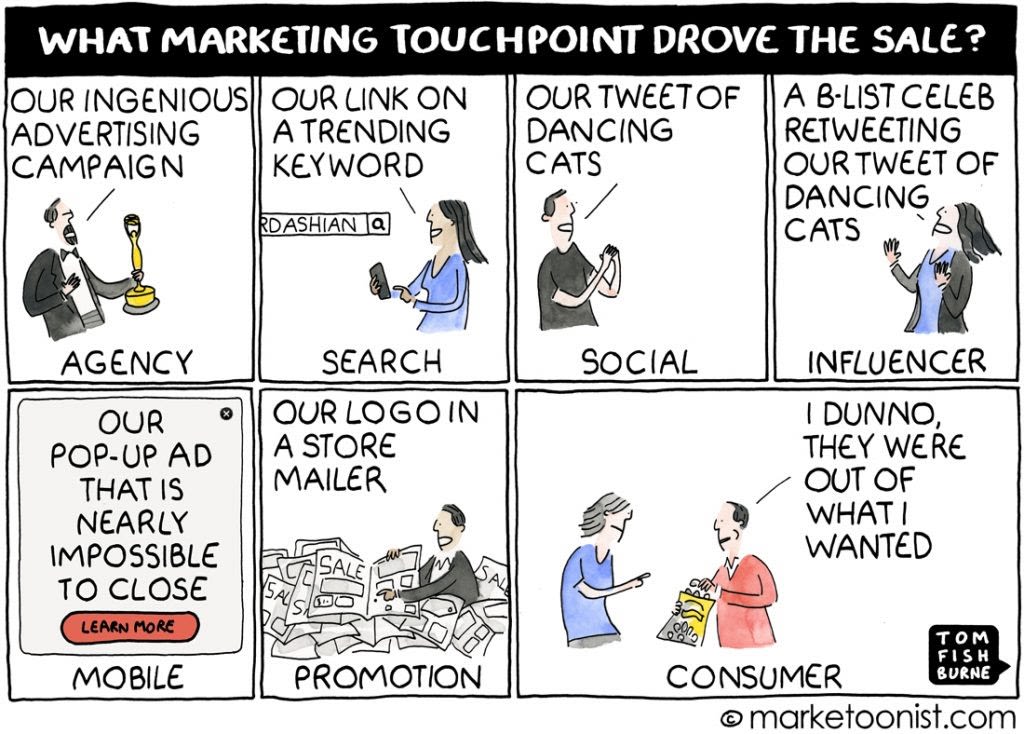
It would be an exercise in intellectual futility to spend this whole article debating the merits of attribution in general, so instead, I’ll focus on the specifics of attribution for content marketing (you can watch this video if you want to go down the “merits of attribution” path).
The answer is that it’s impossible to completely and accurately measure the ROI of content marketing. But that's okay. We can still measure some of our efforts and results in a precise and useful way.
Content, for one, invokes a longer attribution window than many more “direct response” channels like PPC ads. (Which is why we recommend message testing!) Someone could read a blog post in 2008 and sign up for your product four years later if they have a good memory, and no analytics tool will be able to tell you that.
Additionally, content marketing has many benefits beyond simply producing “conversions.” Tim Soulo discusses some of these benefits in this great Tweet thread:
So let’s forget the idea of perfection. You could try to do data-driven attribution modeling using Markov chains to predict the value of a given blog post, but wouldn’t you rather spend that time writing more content?
For our purposes, let’s figure out how to get some utility out of our attribution modeling (i.e. actually making business decisions on this data).
Here’s the formula:
- Define your goals
- Pick an attribution model that suits your goals
- Set up your reports to reflect the attribution model
- Use this data to make decisions and adjust your strategy to produce better ROI
Define Your Goals: What are the Best Content Marketing KPIs?
Every form of attribution needs to start with the same question: what’s my goal?
In order to calculate a conversion rate, you first need to define what a “conversion” means. This depends heavily on your business, but also on how you want to attribute meaningful credit to a blog post.
Is it, for instance, feasible to expect someone to purchase from your eCommerce store after reading a blog post? Maybe. Should your goal be email list signups? Perhaps.
In my experience, mapping all of your content marketing to a singular goal can be problematic (though much simpler analytically).
Content should be mapped to different intent stages on the buyer’s journey, and different intent stages have different expected actions. Top-of-funnel content is lucky to generate an email list signup, whereas bottom-funnel content should be contributing customers.
KlientBoost uses the “PPC temperature” framework, but it can apply to content marketing, too:
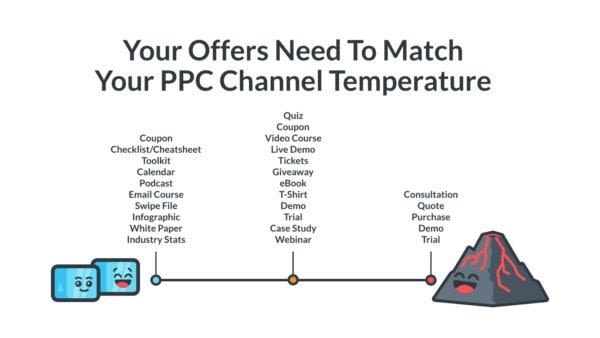
For now, I’d pick a direct response or short-term metric, like email signups or lead conversions. I’d stay away from downstream metrics like churn reduction or LTV, at least until you get the basics in place.
Typically, more holistic attribution requires data integration or at least a more robust analytics solution like Woopra.
To make things simple to measure, you can structure your website so all of your goals have a similar text string in the URL. Something like /thank-you/.
Similarly, you can create a subfolder or subdomain for your blog, such as website.com/blog/blog-post in order to filter only blog content in your analytics tool.
This way, you could have two types of offers -- let’s say ebooks and demos -- and trigger a “conversion” for either of them. They’d have URLs like this:
- website.com/ebooks/ebook-one/thank-you
- website.com/demo/thank-you
This allows you to set up a measurable content funnel.
When you’ve defined this conversion for your business, set up your analytics tool to track this action as a page view which can be filtered by a url (such as /thank-you/) or as a custom action such as “demo booked”.
How you trigger your conversion is irrelevant for content marketing attribution; it’s only important that you do it.
Attribution Modeling 101: How to Allocate “Credit” to Content Marketing
When you’ve defined what success means to you and set up the proper goals and events in your analytics tool, you can explore attribution models.
I’ll warn you, for many businesses these can be overkill and needlessly confusing (not to mention an effective way to cherry-pick data if you’re good at analytics).
Attribution modeling is essentially asking the question, “how much credit should we give to a given touchpoint depending on its order in the customer journey?”
Does the last thing someone does before they convert count? Does the first thing someone does to interact with your brand count? These are strategic as well as analytical questions.
It’s easier to walk you through examples using the most common types of attribution models:
- Last touch
- First touch
- Linear model
- Time decay
- Multi-Touch model
- Data-driven
Last Touch

Last click attribution is what most people think of when they think of attribution.
Who was the last salesperson who talked to the prospect before they converted? What was the last ad they saw before they signed up?
That’s what we’re measuring here. You give 100% of the credit to the last touchpoint, no matter what happened before that. Simple, but clearly missing a lot of the story.
First Touch
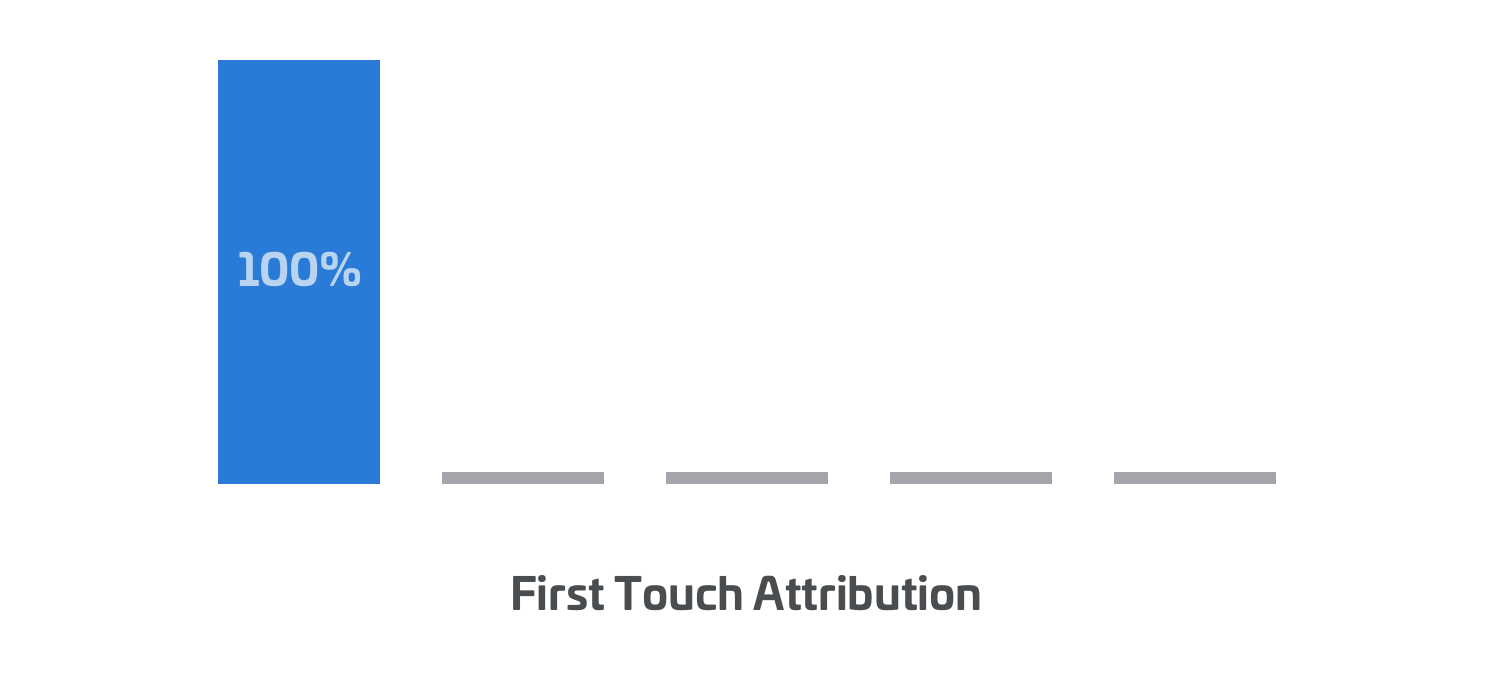
First Touch attribution is the total opposite of the Last Touch. You give all credit to whatever the first touchpoint you can track was.
Now, technically speaking, this is getting more and more difficult to do precisely because of multiple device usage, privacy laws, and cookie deletion.
However, this is a model used when you want to see the true value of brand-based campaigns and top-of-funnel content.
Linear Model
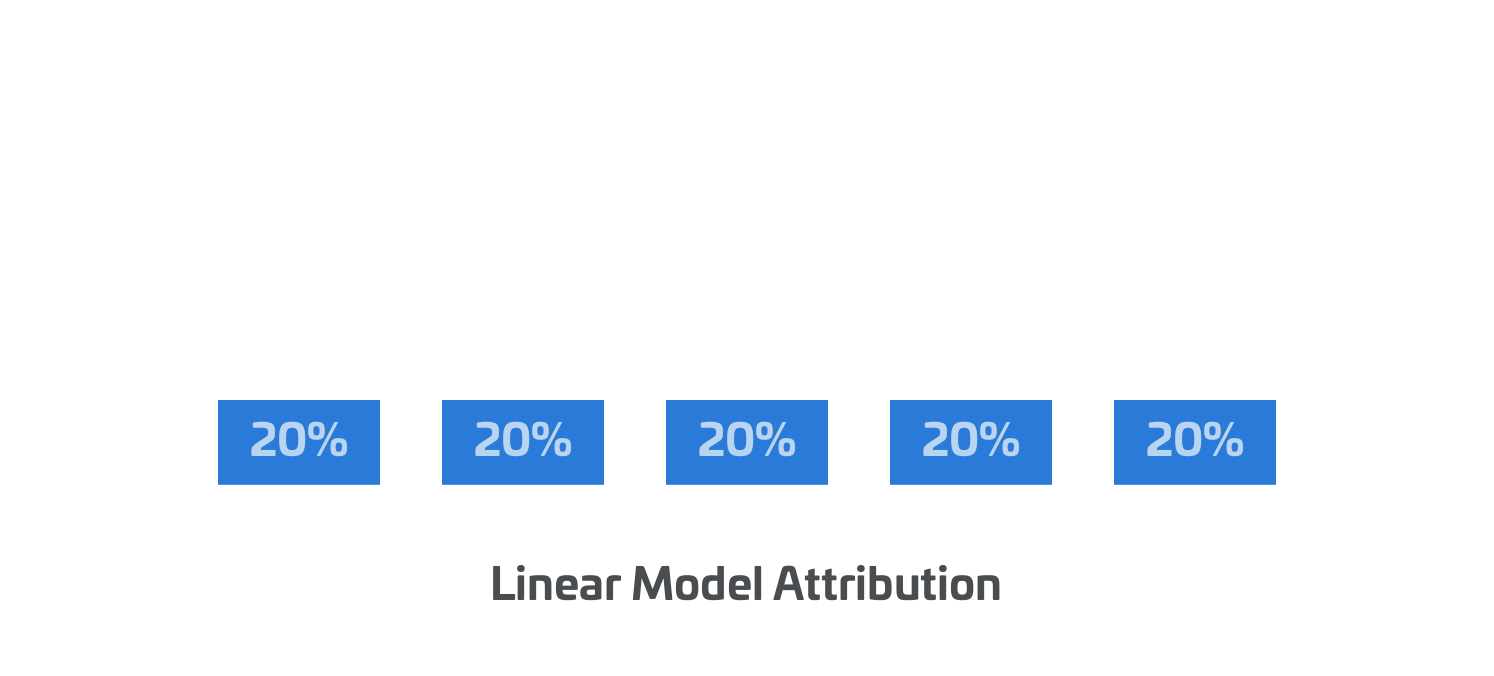
Linear attribution models take all the touchpoints that were tracked and give them exactly the same amount of credit. So if a user reads blog posts A, B, C, D, and E, this model gives them all equal 20% credit, even if one of them was really the one that made them decide to buy.
Time Decay
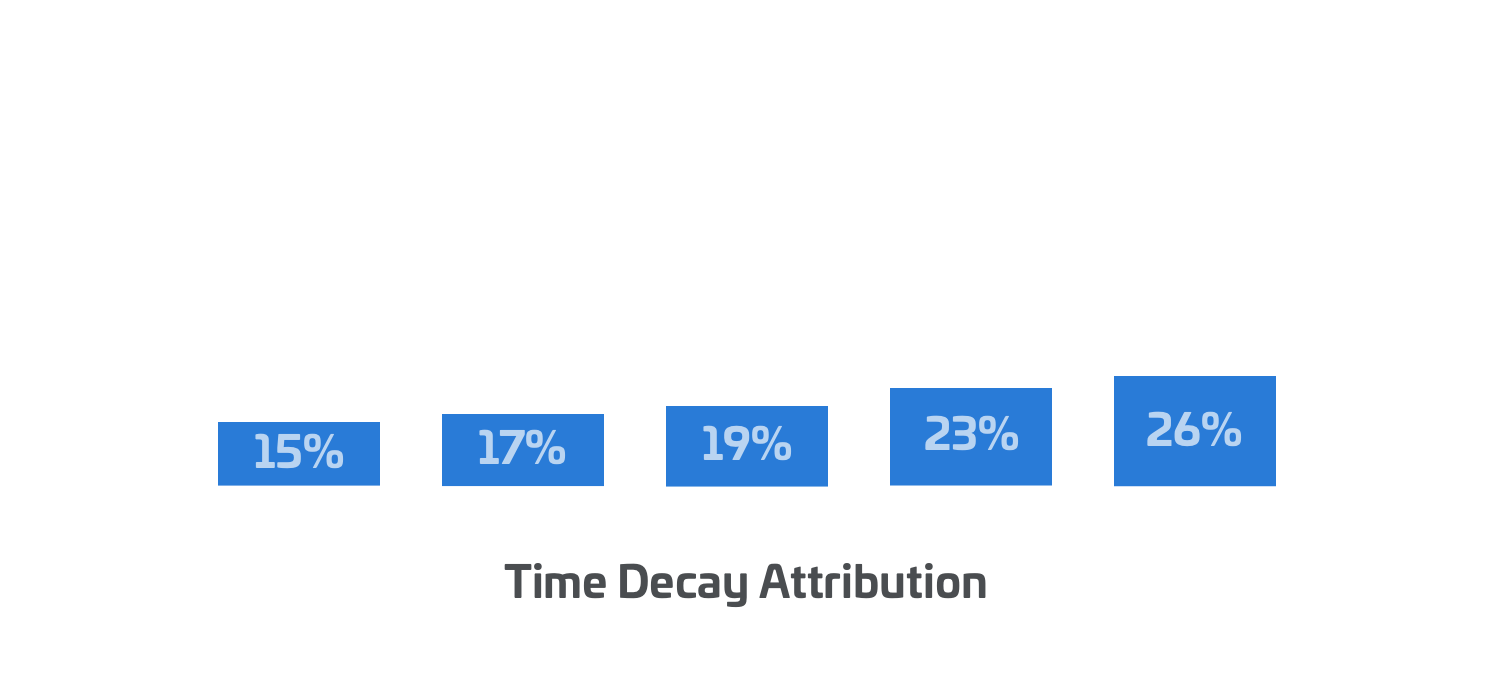
Time Decay models are a bit more complex but rely on similar assumptions, namely that all touchpoints should get some credit.
However, it gives more credit to touchpoints that occur closer to the point of conversion. I actually think this is a decent model, as the first touchpoint still gets some credit for getting people in the door, but the touchpoint before purchase is given the most weight.
Still, there are lots of untested assumptions in this model.
Multi-touch model
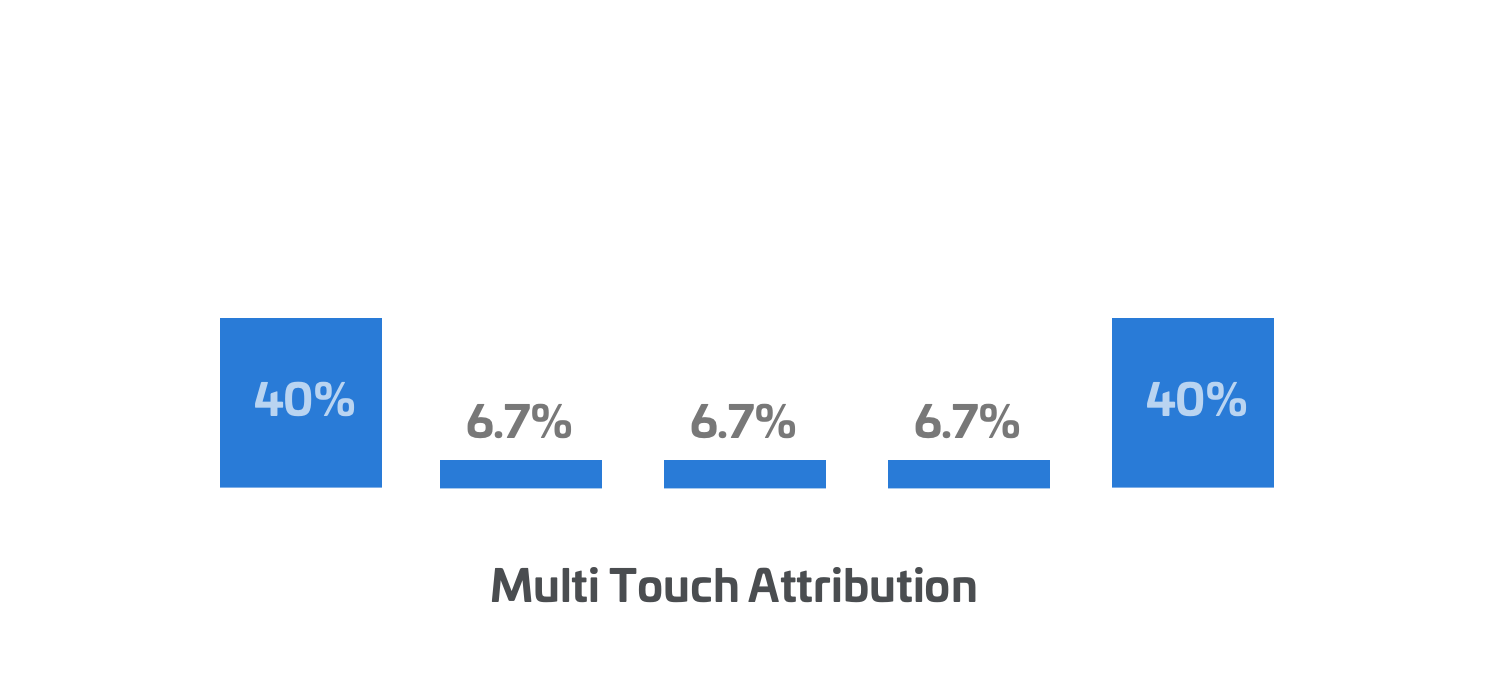
In the Position Based attribution model, 40% credit is assigned to each the first and last interaction, and the remaining 20% credit is distributed to the middle interactions.
Technically, you could change the percentages, but the point remains the same: the first and last are heavily weighted, and those in the middle are less weighted. Here’s how you can configure this in Woopra:
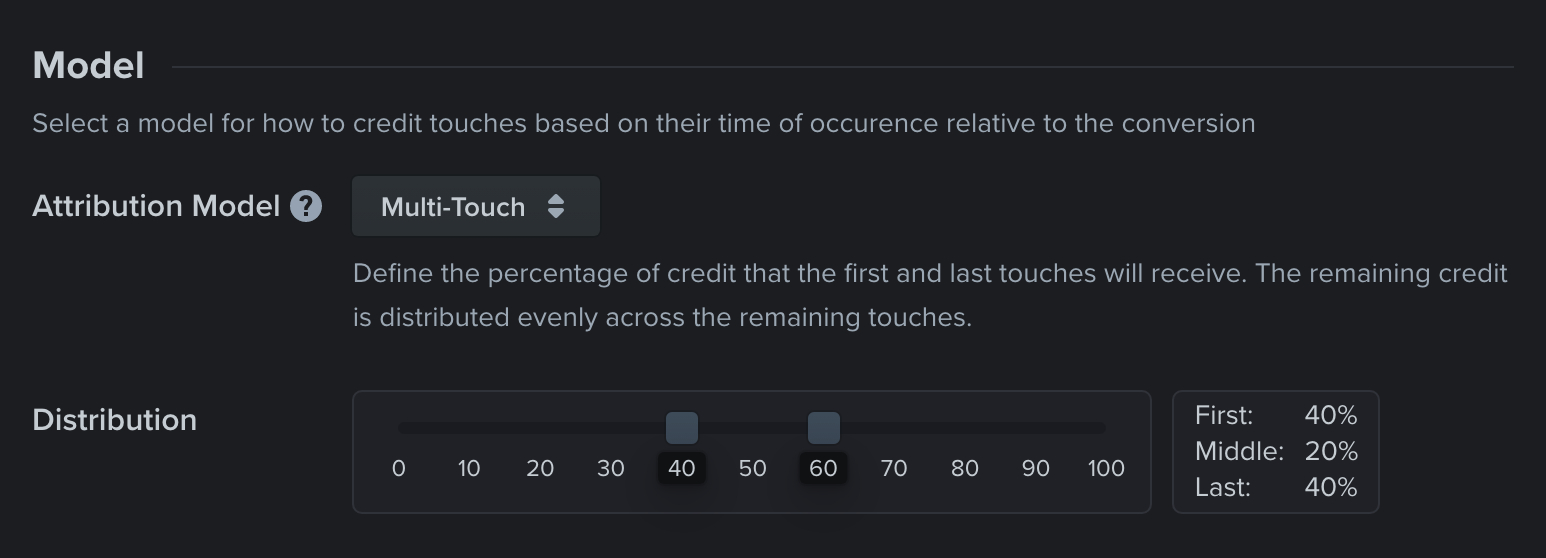
Again, I think this is actually a reasonable model from a common-sense standpoint. The first touchpoint clearly did a lot of work by getting someone in the door and the last touchpoint scored the goal.
But it’s still based on untested assumptions (i.e. that the middle touchpoints didn’t carry much weight).
Data-Driven Models
These are the common models. There’s also what’s generically known as “data-driven attribution modeling” or “algorithmic attribution modeling.”
These use machine learning -- typically a statistical technique known as Markov chains -- to predict the relative weight of a given event or touchpoint.
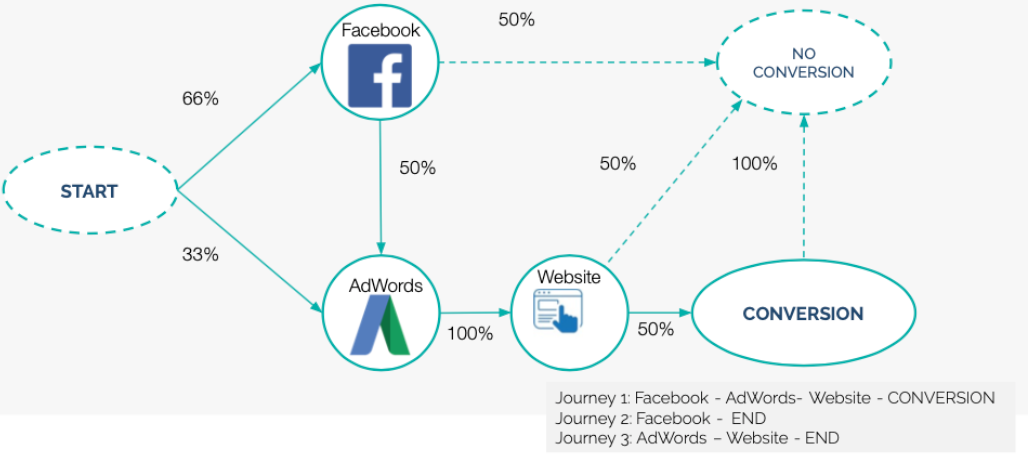
Another model used by large companies employing tons of ad dollars is a sort of “hold outset” -- you eliminate, for a short time, a given campaign in a given market and determine its impact by comparing it to other segments of the market that still included that campaign.
In other words, if a given segment isn’t shown a set of ads but still converts at the same level as those that do see the ads, then the ad is clearly not doing much.
The Simplest Content Marketing Attribution Model
I’m going to be completely honest. I only use two attribution models, depending on the business goals we’re trying to hit:
- First Touch
- Last Touch
In 95%+ of cases, I use last touch models.
Why?
Because I’m trying to prove to clients that we’re delivering business value, which is measured in performance metrics like ad campaigns are.
They’re aware this misses a large part of the story, but through time-series trends and in comparison with all other blog posts, it shows you if you’re making directional progress.
In cases where the content we’re producing is quite top of the funnel and the business has a heavy sales-driven go-to-market, my content agency uses first touch attribution. This almost certainly overweights the importance of the first blog post that drew the visitor to the site, but if it’s a top-of-funnel content play, that’s the story we’re trying to tell.
Here’s how you set up a report in Woopra showing last-touch attribution for organic blog posts.
First, in order to compare apples to apples, your cohorts must all all have their first visit within the date range of your report. So define the cohort as Any Action where the First visit is true.

Second, set up your Touchpoints as follows:
- Select _Pageviews _
- Add the following constraints:
- Is First Action: true
- URL contains /blog
- Referrer Type is a search engine.
- Select the URL as the dimension.
This will ensure it will only count the last blog post through which they entered your site from an organic search and breakdown the report by the blogpost urls:

Third, make sure you’ve set up your conversion goal. In this case, I’m analyzing the signup attribution:

Finally, set the attribution model to Last Touch:

When you hit the run button, you’ll see the following report:
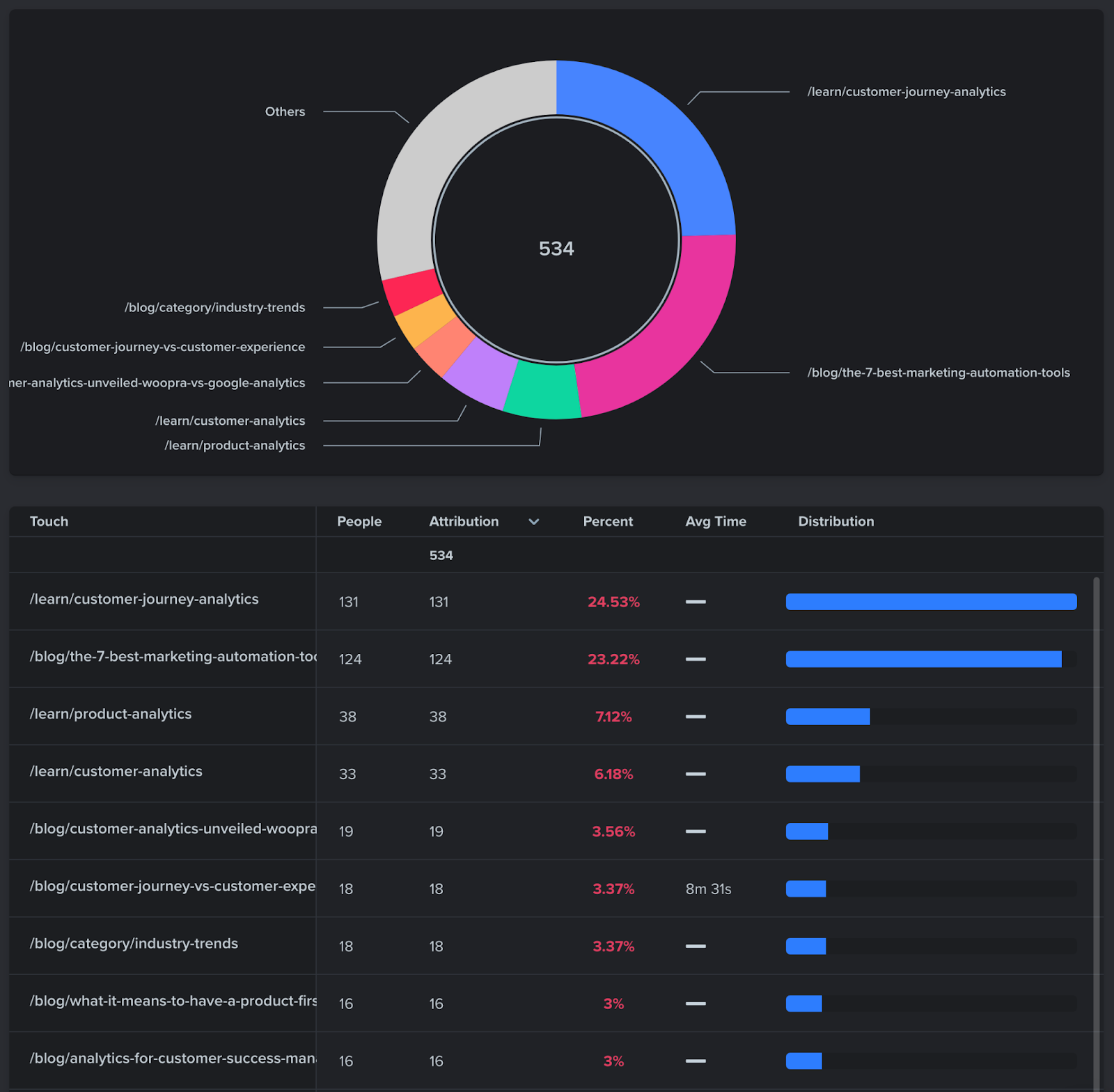
Now we can see the breakdown of articles generating conversions.
Not to hammer this point too hard, but people can argue all day about various content attribution models. In my opinion, a model that measures direct response is best.
My logic is that this way you can treat content as a performance channel and still know in your heart of hearts that you’re under-attributing the channel because of all the intangible things you’ll track.
A simple model reduces arguments, proves value in relation to core business metrics, and leaves you to focus on the work of improving those numbers.
Plus, it incentivizes product-led content, which more brands should be writing, anyway.
Content Marketing Attribution is an Iceberg (Emergent Properties and Serendipitous Upside)
As I mentioned, content marketing doesn’t just drive traffic and conversions. It drives opportunity.
Here are a few benefits of content marketing you won’t find tools like Woopra or Google Analytics:
- Helps drive partnership opportunities
- Gives you leverage in partnerships due to increased audience and value
- Additional monetization opportunities (ads, subscription, affiliate, new products, etc.)
- You learn a massive amount about your audience by what they read and comment
- Content can form the first steps of a community. Communities are powerful moats.
- Speaking opportunities, guest writing opportunities, and other forms of exposure for writers and founders.
- Implicit trust and credibility built through authorship. Hard to measure this one.
You could try to measure some of this stuff, but in my opinion, it’s best to take the emergent properties like a cash bonus and don’t question it too much.
I’d be remiss if I didn’t also mention that content marketing has hidden costs associated with it, too.
Of course, there’s the cost of your internal hires and freelancers, but you also introduce cross-functional complexity and costs through the work you’ll do with associated teams like the product, product marketing, conversion optimization, sales, and potentially, localization and internationalization if you hope to translate content.
It could also be an opportunity cost, depending on the business. And finally, there are many hidden costs of SaaS tools and data associated with building out this channel.
That said, the hidden benefits outweigh the hidden costs.
Content marketing is not only a long-term channel, but it’s a channel that helps with all other channels. Your sales team will find the content that helps them close sales.
Your paid acquisition team will find the brand benefits of content help lower CAC. Your partnerships teams will be able to leverage your blog to structure better comarketing and strategic deals.
It’s all upside, but what we can measure is limited. This is a feature, not a bug, of content marketing.
Conclusion
Content marketing attribution, like any form of attribution modeling, is a tradeoff between utility and precision. The more precise you are, the more complex the model gets, and the less useful and comprehensible it will be for decision making.
My simple advice: depending on how your company primarily uses content marketing (as a brand builder or as a performance channel), use a first touch or a last-touch model, respectively.
And then stop arguing about the philosophical merits of other models, and start writing good content.


